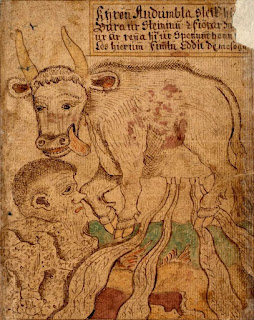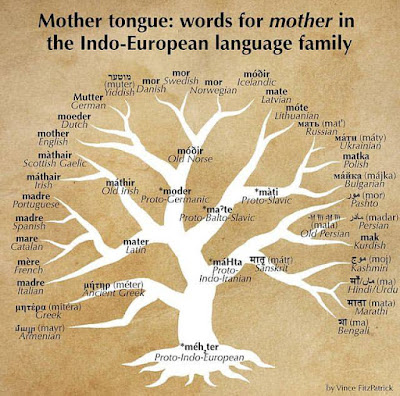Holy Cow! Musings on Auðumbla
What do Hinduism and Heathenry have in common? Proto-Indo-European roots and the potential for “Holy Cow” jokes!
One figure in Nordic mythology that I always find fascinating is Auðumbla. Who is this cow, and how did she become a part of the creation story? Is Auðumbla a goddess? Where did she come from? And if she is a cow, why does she have horns?
First of all, it seems like there is something funny going on here. Auðumbla is a cow in so far as she is female, but she is no domesticated cow. In fact, she is most likely an auroch, hence the horns. You may have heard of aurochs before if you have done some delving into the runes (or not). Basically, they were wild cattle with huge horns that lived in the forests of Northern Europe. Sadly, they are now extinct.
How did the elder Heathens view aurochs? They associated them with the forests, and wild energy. They also saw them as strong and persevering.
So then, it makes sense that Auðumbla, an auroch, was seen as a powerful force and the bridge between chaos and order, just as the aurochs were the bridge into domestication of cattle and the beginning of agriculture. With agriculture we can see how Auðumbla might also be associated with fertility, and even rain. She licks the salty rime to reveal Buri. (A cow licking salt? No way!) But what exactly is rime? It is a type of ice that forms out of supercooled fog and makes a coating on the outside of objects. Basically it is a very thick frost. It often occurs near the ocean or large bodies of water in the winter.
How did Buri get Buried in rime? It is hard to say. Where did Auðumbla come from? Or Ymir for that matter?
We do know Ymir drinks milk from Auðumbla for nourishment, so it seems that the existence of Auðumbla may have pre-dated even Ymir, who slowly dripped from the rime while Auðumbla sprang into existence. If we look at Gylfaginning we get a clearer picture:
Then Gangleri asked: "Where did Ymir dwell, and how did he find sustenance?"Hárr answered: "Straightway after the rime dripped, there sprang from it the cow called Auðumbla. Four streams of milk ran from her udders, and she nourished Ymir."Then Gangleri asked: "And how was the cow nourished?"And Hárr answered: "She licked the ice-blocks, which were salty; and the first day that she licked the blocks, there appeared in the evening a man's hair; the second day, a man's head; the third day the whole man was there. He is named Búri. He was fair of feature, great, and mighty. He begat a son called Borr, who married the woman named Bestla, daughter of Bölthorn the giant; and they had three sons: one was Odin, the second Vili, the third Vé. And this is my belief, that he, Odin, with his brothers, must be ruler of heaven and earth; we hold that he must be so called; so is that man called whom we know to be mightiest and most worthy of honour, and ye do well to let him be so called."
From this we see that Auðumbla appeared as soon as the rime began to drip. Perhaps she came from the rime itself or perhaps from Ginnungagap. In many ways it makes sense that the cow appears first because it explains from a Nordic perspective, as the Auroch would have been seen as necessary for life. The auroch represented wild energy, fertility, femininity, and the ability to overcome obstacles. They were the precursor to cattle, and we know that the elder Heathen saw the cattle as representations of wealth and prosperity.
Auðumbla was a wild, feminine, creative force, in some ways also the primordial mother. Nurturing and life-giving before Odin and his brothers created the 9 worlds and the Æsir took up their rule from Asgard. In Nafnaþulur we see the names used for cows by the elder Heathens:
Kýr heitir skirja,
kvíga ok frenja
ok auðhumbla,
hon er elzt kúa.
A cow is called heifer,
She-calf, and romping lass,
and Auðumbla,
She is the first (noblest) cow.
We can note 4 main things about Auðumbla:
i) She is primordial,potentially even the first being.ii) She is a cow - she is a female/mother figure.iii) She provides milk in four divisions/streams.iv) She uses her tongue to sculpt gods into being.
This is important because we discover that there are other similar figures in Indo-European cultures. The most striking is the Hindu Kamadhenu. My understanding of Hindu stories is limited, so bear with me, but from what I can tell Devi is the word for the Divine Mother, who can take many forms and one is Kamadhenu, a cow. She is seen as the mother of all cows. Another form of Devi is Vak, the goddess of speech and the speech comes in 4 streams, equated with the udder/milk. And it is speech that brings things into being in this case. Hopefully I didn’t butcher that story too much.
Here is a bit from Brihadaranyaka Upanishad:
One should meditate upon speech (the Vedas) as a cow (as it were). She has four teats—the sounds ‘Svāhā,’ ‘Vaṣaṭ,’ ‘Hanta’ and ‘Svadhā.’ The gods live on two of her teats—the sounds ‘Svāhā’ and ‘Vaṣaṭ,’ men on the sound ‘Hanta,’ and the Manes on the sound ‘Svadhā.’
Vak brings forth a tribe of gods through sculpting them with speech, very similarly to how Auðumbla brings forth the Æsir by “sculpting” them out of the ice with her tongue. That said, there is also some argument to be made that creation also came from sound, or vibration, in the Heathen story.
To me these similar stories seem to suggest that there was a cow goddess in Proto-Indo-European religion and she gave way to the new gods, in Heathenry the Æsir, but probably was still worshipped, at least in the transition period. So yes, Auðumbla could be considered a goddess, and there would be some solid grounds for worshipping her. Cow worship was common historically, as cows represent nourishment, creation, and good health. Cows helped to create order out of chaos by providing stability for early peoples, allowing for agriculture and creation of structured communities of larger sizes.
Just as cows helped to order the world of our ancestors, aurochs may be helping to reorder our modern world. As I was researching for this post I stumbled across articles about using DNA to recreate the aurochs in Europe and helping to rewild tracts of land there. Aurochs may be coming back, and perhaps the primordial cow goddess along with them.
Further Reading and Viewing:
“Audhumbla: Sacral Or Sacrificial?” https://www.facebook.com/AryaAkasha/photos/1124343084844681
“Auðumbla - Mother’s Day Revisited” https://everydayheathenry.wordpress.com/2016/05/30/audumbla-mothers-day-revisited/
“Aurochs: back from extinction to rewild Europe” https://www.mossy.earth/rewilding-knowledge/aurochs-rewilding
“Ginnungagap - The Primordial Darkness” https://arithharger.wordpress.com/2019/02/27/ginnungagap-the-primordial-darkness/
Gylfaginning https://www.sacred-texts.com/neu/pre/pre04.htm
Image Source:
“Auðumbla licking Búri out of rime as four rivers of milk pour from her udders.” (From an 18th century Icelandic manuscript of Prose Edda.)



